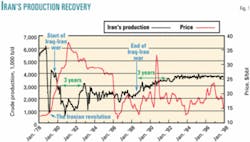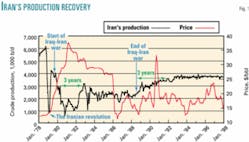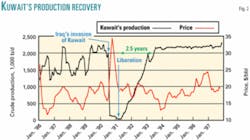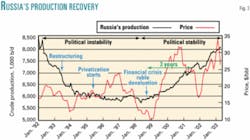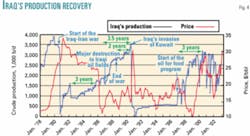Experience with countries disrupted by wars and severe social change in the Middle East and Eastern Europe shows a pattern of about 3 years to regain stability in the oil industry.
In the present case of Iraq, however, rebuilding will require massive financial assistance from the US and its allies because the country is caught in a vicious cycle. Iraqis cannot repair and construct new facilities without oil revenues, but they need those revenues to rebuild the oil sector.
Now that the US Congress has approved the $87 billion that the Bush administration has requested for Iraq and Afghanistan—of which about $20 billion will be used to rebuild Iraq's infrastructure and revamp its oil industry—will Iraq be able to restore its preinvasion oil production capacity quickly?
US government assistance is, in fact, the best and the fastest way to solve immediate problems in Iraq. No viable alternative to direct US funding is imminent.
Other governments have shown a limited inclination to commit adequate funding to the rebuilding effort, and it will be years before foreign investors undertake projects in Iraq.
Private foreign investment requires Iraq to have a legal and representative government, political stability, infrastructure, good institutional framework, and a government committed to the protection of foreign investment. No one expects these conditions to exist in Iraq in the near future.
US assistance eliminates one of the main obstacles to oil production capacity expansion—funding. However, restoration of preinvasion production capacity still depends on many other factors, including:
- The speed of money transfer from the US to Iraq.
- The speed of achieving political stability.
- The speed of advanced technology transfer to Iraq.
The availability of capital, technology, expertise, and the political will to increase production capacity should speed up the restoration of production capacity to preinvasion levels, but not as quickly as many people expect.
The experiences of other countries that have suffered from wars and political instability suggest that even if all these resources are available, it will take time to expand capacity. US assistance will speed up the process, but it will still take time to bear fruit.
Historical data from four oil-producing countries which have suffered from political turmoil and wars—Iran, Kuwait, Russia, and Iraq itself—indicate that it took at least 3 years in each case to increase capacity to sustainable levels.
Among these countries, only Kuwait was able to restore its previous capacity. The other countries have not yet been able to do so.
Iran
Fig. 1 shows Iran's production vs. oil prices. The 1979 Iranian revolution brought Iranian oil production to a complete halt. Labor strikes and subsequent political turmoil stopped oil production but did not damage production capacity.
Iran increased its production quickly, once workers went back into the oil fields.
The Iraq-Iran war started on Sept. 23, 1980, after Iraqi President Saddam Hussein had unilaterally canceled a 1975 treaty with Iran 6 days earlier. The war led to another complete halt of Iranian production.
The combination of labor strikes, the Iranian revolution, and the start of Iraq-Iran war, increased the world price of crude oil from around $14/bbl at the beginning of 1979 to more than $35/bbl in January 1981. Iraq inflicted major damage on Iran's oil facilities, which resulted in a decline in Iran's production capacity.
Under financial pressures, the Iranian government embarked on a desperate program to increase oil production capacity. Iran raced furiously against time to restore its production to acceptable levels, but it still took 3 years to increase its capacity to levels at the beginning of the war.
The war ended in August 1988, but it took Iran another 3 years to increase capacity by 1 million b/d and 4 years to reach sustainable levels.
Kuwait
Fig. 2 shows Kuwait's oil production vs. oil prices from 1986 to 1998. Despite political stability and the availability of capital, technology, expertise, and international help, it took Kuwait 21/2 years from the day of liberation to fully restore production capacity crippled by Iraq's invasion and subsequent sabotage in 1990-91.
Russia
Maturing oil fields, lack of advanced technology, poor management, corruption, and the collapse of the Soviet Union led to a sharp decline in Russia's oil production capacity after 1991.
Russia's capacity continued to decline despite the restructuring efforts that started in 1993 and the privatization that started in 1995. Political and economic instability, corruption, a poor record of corporate governance, an unstable legislative framework, and lack of legal protection for foreign investors are among the factors to blame for the decline in production capacity.
The financial crisis in August 1998 marked a turning point for the Russian oil industry. Reforms, accompanied by political and economic stability and devaluation of the ruble, created a better investment climate and lowered exploration and development costs.
Russia's oil production capacity started to increase in 1999. However, despite political and economic stability, reform, privatization, higher oil prices, lower costs, and the availability of capital, it took about 3 years to increase oil production by about 1 million b/d (Fig. 3).
Iraq
Iraq's production plunged after the start of the Iraq-Iran war in 1980. It recovered quickly, but major damage in 1982 reduced production capacity by more than 600,000 b/d. From that date, it took Iraq 3 years to increase its capacity by about 1 million b/d.
Capacity declined again toward the end of 1986 after several successful Iranian attacks, and it took Iraq 31/2 years to increase its capacity.
After the war ended in August 1988, it took Iraq 2 years to increase its capacity by about 750,000 b/d. The experience of other countries tells us that Iraq could have increased its capacity by about 1 million b/d within 3 years, but the invasion of Kuwait stalled that process.
In August 1990, Iraq invaded Kuwait. Immediately after the invasion, the United Nations Security Council unanimously approved Resolution 660 condemning the Iraqi invasion and calling for an immediate and unconditional withdrawal.
The UN Security Council approved resolution 661, which imposed mandatory and complete embargo of all investment and trade—including oil—with Iraq and occupied Kuwait. The embargo stopped Iraqi oil exports and reduced world oil supplies by about 4.5 million b/d.
In the following months, the UN Security Council issued two resolutions that have had profound impact on world oil markets, even today. On Oct. 29, the Council passed Resolution 674 that made Iraq liable for damages, injuries, and financial losses resulting from the invasion and occupation of Kuwait.
On Nov. 29, the Council approved Resolution 678, which authorized the use of all necessary means to force Iraq out of Kuwait if Iraq did not withdraw by Jan. 15, 1991.
Resolution 674 forced Iraq to produce more oil in later years to pay for compensation. Resolution 678 led to the 1991 Iraq war and its aftermath.
After months of military preparations, political maneuvering, and a change in objectives from the protection of Saudi Arabia to the liberation of Kuwait, on Jan. 12, 1991, the US Congress authorized President George H.W. Bush to use all necessary means to force Iraq out of Kuwait.
When Iraq did not withdraw by the deadline, coalition air strikes initiated Operation Desert Storm on Jan. 16, 1991. On Feb. 28, Iraq accepted all relevant UN Security Council resolutions. The war ended with Kuwait liberation.
Still, Iraq was not able to export oil until the UN oil-for-aid program was signed in May 1996, based on UN Resolution 986.
The resolution allowed Iraq to export oil and buy badly needed spare parts for its oil industry.
The repair of a pumping station on the Iraq-Turkey pipeline and the establishment of UN monitoring and aid distribution facilities delayed implementation of the agreement for several months.
It took Iraq 3 years after implementation of the agreement to reach sustainable levels of production (Fig. 4).
The figures show that 3 years has become the rule of thumb for capacity recovery in major strife-torn oil exporting countries.
The experiences of various countries, including Iraq, demonstrate that it will take about 3 years from the time political stability is restored in Iraq for Iraqi oil production to reach its prewar levels.
It may take even longer. The experiences of Iran, Kuwait, Russia, and Iraq indicate that major capacity increases require political stability—something Iraq does not have at this time.
At the very least, continued bombing of pipelines will hinder Iraq's efforts to increase its exports and generate revenues to revamp its oil industry.
Iraq's oil production will not increase quickly or substantially even with immediate US assistance.
US assistance may break the vicious cycle in Iraq, but it will not lead to a rapid increase in production capacity.
Questions remain
The inability of Iraq to increase its production capacity quickly will have significant implications for the foreign and energy policies of the US.
If Iraq cannot increase its production quickly and significantly, how will the US pay for the reconstruction of Iraq?
Who will pay to maintain a fragile Iraqi democracy? Can the US maintain its presence if it cannot provide food, health care, employment, and basic services to the Iraqi people?
Can the US maintain law and order without a strong police force and an effective court system in Iraq, both of which will be expensive to establish and maintain?
And is the administration's $20 billion enough for Iraq? Probably not. In any case, Iraqi oil will be the solution to no one's problems until a stable, democratic regime is in place and functioning there.
The author
A.F. Alhajji ([email protected]) is an associate professor of economics at the University of Northern Ohio at Ada, Ohio. He was a research assistant professor and visiting assistant professor at Colorado School of Mines during 1997-2001. He taught for 3 years at the University of Oklahoma, where he received his PhD in petroleum economics in 1995. Alhajji has published more than 300 articles and columns.
